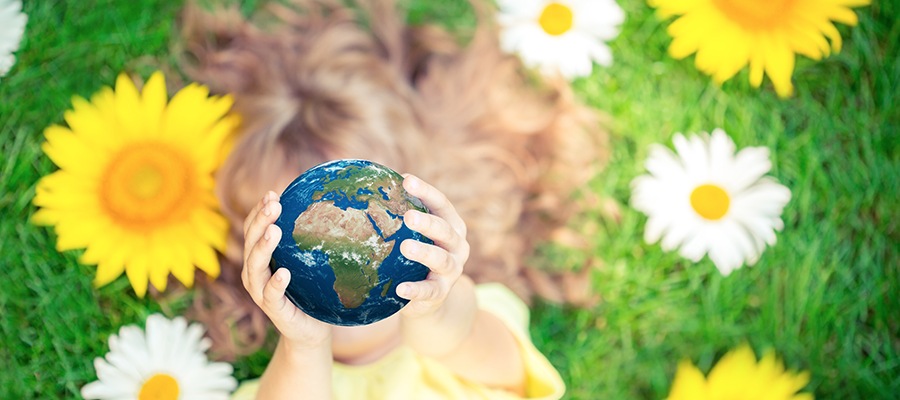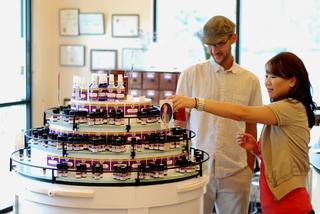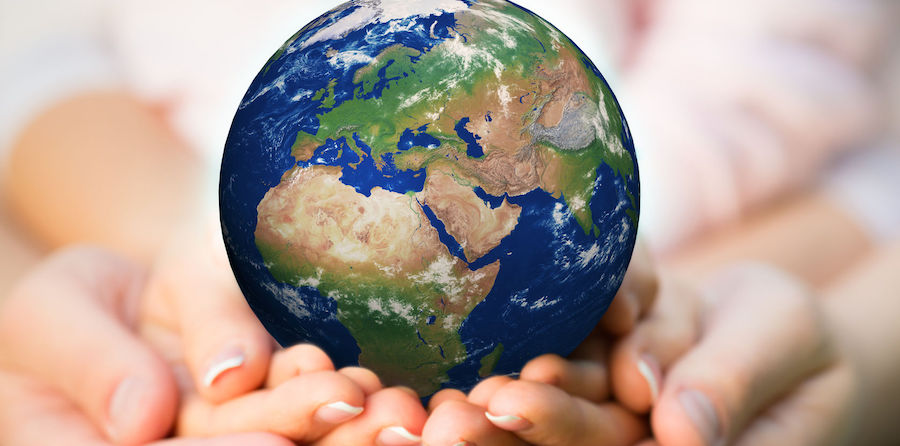By Lauren Torchia and Renee Long
Image Copyright: yarruta / 123RF Stock Photo
Earth Day is on the way, but the war on trash rages on. It's piling up despite our best efforts to pay forward practical education about recycling and conservation. Think about this: the U.S. produces enough trash to fill 63,000 trash trucks daily. Placed end to end, that’s enough trucks full of plastic, garden clippings, clothes, furniture, bottles, food, and newspapers (not to mention batteries, light bulbs, and paint!) to reach halfway to the moon (119,450 miles). And if that wasn’t weird enough to think about, plastics take more than 400 years to degrade. So, the estimated “8 million metric tons of plastic [that] ends up in the oceans every year … the equivalent to five grocery bags of plastic trash for every foot of coastline around the globe,”[1] is going to be there for a while. Sigh.
Buuuuuut, it’s not all doom and gloom. So long as we keep the torch burning for Mother Earth and our children’s inheritance in mind, there is hope … and tiny houses to save us! Seriously. There’s a lot we can do to intervene and stop this landslide of landfill leftovers from taking over our future.
To help reduce the amount of tossed trash, the EPA recommends prevention, recycling, and composting. That’s not exactly new information. But, there are a lot of new ideas about how to integrate these principles into an eco-friendly lifestyle that works for you. How? you say.
Here are three novel and simple ways to be a conscientious consumer whether you want to dip your toe in the water or go great guns.
1. Treat Yourself at the Thrift Store
Fashion isn’t a bad thing. There’s no shame in wanting to look and feel your best with a wardrobe that expresses your personality. But, fast fashion might be a different story.
“Fast fashion” describes the quick seasonal cycles in the fashion industry; clothes are produced for sale quickly after they hit the runway to capitalize on trends. The challenge is: who can keep up? And if you can, is it worth it? Literally? A downside of fast fashion is poor quality, clothes that fall apart and often wind up in the trashcan. According to The Atlantic, only 15% of used clothing is donated; the rest, approximately 193,000 tons, is tossed annually.[2]
Whoa! All those must-haves are turning into musty mice nests or who knows what else in our landfills. While cotton breaks down a lot faster than plastic (about one to five months[3]) what about fabric blends? Or polyester? Non-biodegradable fabrics like polyester, spandex, and nylon take between 20 to 200 years to break down.[4] Those tummy tamer shapewear shorts just won't quit. LOL.
Plus, it’s just sort of a waste of money. I mean, if you have the means, why not make the most of it and either buy quality clothing that will last for years to come or tailor your wardrobe with gently-used items from clothing resellers like your neighborhood thrift store, consignment store, or an online community like Poshmark. Thrifting for style has become even more popular in the last decade.
Of all the ideas listed in this blog post, this one is the simplest. It’s low commitment and just takes a little preplanning. It also has the benefits of[5]:
- An endless buffet of new items daily
- Designer pieces at a fraction of the cost
- Sales, sales, and sales!
- A stylish wardrobe that is uniquely YOU!
2. Revamp Your Recycling Game
We spilled the beans in a previous post that “Americans throw away enough office paper each year to build a 12-foot-high wall from Seattle to New York (a new wall every year).”[6] That’s bonkers!
Trash comes from our homes, schools, and businesses. So, there is a lot of opportunity to up your game and renew your commitment to recycling. If you need a visual motivator, just check out these sea turtles who need a clean ocean to thrive, bless their hearts. Or, take a cue from this Southern California kid who has earned approximately $35,000 dollars recycling the cans and bottles from his community.
If you think it’s hard … well … you’re right. The symbols printed on the bottom of recyclables can be hard to decode, let alone memorize. The good news is, you don’t have to.
There are many websites like this one that decode the symbols for you. And, your local trash services company will provide a more specific list of what can and cannot be recycled in your area. They might even have a nifty poster or cheat-sheet you can hang near your trash bins so you don’t have to remember anything other than to recycle!
Work in an office? You have a built-in opportunity to make an impact. At ACHS, we say, think twice before you print. If you stopped to think about it before hitting the print button, how much paper could you save?
Lastly, don’t forget electronic waste! Before you kick your old T.V. or iPhone to the curb, see if there is a takeback program you can take advantage of. The Electronics TakeBack Coalition has compiled some options. Or, re-sell your old electronics for a bit of pocket change! Renee recently sold a silver iPod Classic for $80 on OfferUp, a simple app that helps you buy and sell locally. That’s a nice wad of extra green and it saved one more electronic from the landfill.
3. Toss Toxic Cleaners and Clean Green
Who doesn’t love the smell of a freshly cleaned home? But have you ever had that light-headed feeling after cleaning the bathroom with bleach or another industrial chemical?
The truth is, most conventional cleaning products are highly toxic to both your body and the environment. The EWG says that fumes from many store-bought cleaners “may induce asthma in otherwise healthy individuals. A large and growing body of evidence links frequent use of many ordinary cleaning supplies at home or on the job with development of asthma and other respiratory problems.”[7] Plus, many conventional cleaners are known carcinogens.[7] Yikes!
Remember Finding Nemo? “All drains lead to the ocean!” Yup. Everything you flush down the sink, toilet, or any other drain ultimately ends up in rivers, lakes, oceans, and other water sources. This is poisoning our aquatic life the same way it’s poisoning humans (see above).
Here’s just one example: phosphates in household dish and laundry detergent trigger the growth of algae, which then zap the oxygen from the water.[8] This means fish and other aquatic life die off, damaging a delicate ecosystem.
Enter essential oils. That’s right… aromatherapy can do more than soothe an anxious mind or create beautiful natural products. Essential oils are powerful green cleaners! Oils like eucalyptus, lavender, peppermint, tea tree Australia, rosemary, and all citrus oils can put some serious muscle and delightful aromas into your natural cleaning game.
For tips on getting started, download our Green Spring Cleaning eBook and read our blog post on swapping toxic cleaners for natural essential oils. Your body and the environment will thank you!
Sustainability is a pillar of our mission and vision at ACHS. Did you know sustainability and environmental stewardship is covered in our HERB 101 Basics of Herbalism Online course? Or, maybe you want to explore all the ways essential oils can promote health and reduce the number of toxins flushed into the environment with a Certificate in Aromatherapy.
Help educate and coach others to care for their bodies and the earth by enrolling in one of ACHS’s holistic health and wellness courses.
Disclosure of Material Connection: I am the Dean of English and Director of Communications of American College of Healthcare Sciences, the Institution that publishes this blog. However, all opinions are my own. This blog may contain affiliate links. I am disclosing this in accordance with the Federal Trade Commission’s 16 CFR, Part 255: “Guides Concerning the Use of Endorsements and Testimonials in Advertising.”
This article is for informational purposes only. It is not intended to treat, diagnose, cure, or prevent disease. This article has not been reviewed by the FDA. Always consult with your primary care physician or naturopathic doctor before making any significant changes to your health and wellness routine.
References
[1] Parker, L. (2017, July 19). A whopping 91% of plastic isn't recycled. National Geographic. Retrieved from https://news.nationalgeographic.com/2017/07/plastic-produced-recycling-waste-ocean-trash-debris-environment/
[2] Cline, E. (2014, July 18). Where does discarded clothing go? The Atlantic. Retrieved from https://www.theatlantic.com/business/archive/2014/07/where-does-discarded-clothing-go/374613/
[3] Delaney, P. (2013, February 14). How long it takes for some everyday items to decompose. Retrieved from http://www.down2earthmaterials.ie/2013/02/14/decompose/
[4] Close the Loop. (n.d.). Retrieved from https://close-the-loop.be/en/phase/3/end-of-life
[5] Beirne, K. (2015, May 11). 6 benefits of thrift store shopping. Retrieved from http://nooga.com/169860/6-benefits-of-thrift-store-shopping/
[6]Recycle Across America. (n.d.). Retrieved from http://www.recycleacrossamerica.org/recycling-facts
[7] Environmental Working Group (EWG). Cleaning supplies and your health. (n.d). Retrieved from https://www.ewg.org/guides/cleaners/content/cleaners_and_health#.Ws0DrtPwaqm
[8] Franklin-Cheung, A. (7, October 2017). How do household cleaning products affect the environment? Science Focus. http://www.sciencefocus.com/article/planet-earth/how-do-household-cleaning-products-affect-environment






